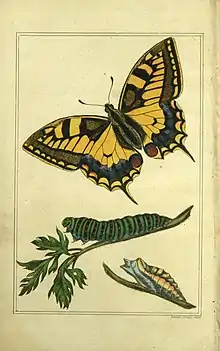Laetitia Jermyn
Laetitia Jermyn (1788–1848)[1] was a British entomologist, illustrator and author.[2] She was mentored by William Kirby, to whom she dedicated her best remembered work: The Butterfly Collector’s Vade Mecum,[3] meaning 'ready reference'.[4]

Life
Laetitia Jermyn, was born in Suffolk in 1788, the daughter of an Ipswich book seller.[5] Her family allowed her to foster an interest in butterflies, and she was encouraged too by her neighbour William Kirby.[6] Jermyn was said to have 'cultivated wide literary tastes.'[5]
In 1830, she married Dr. James Ford, an antiquary, scholar, and vicar of Navestock, Essex.[5] Ford was a significant benefactor of Trinity College, Oxford, and the Ford Lectures are named for him.[5] He was said to be 'an ardent bibliophile, studious, punctilious, meditative, but also rather pompous and intolerant.'[7] He one Sunday rebuked his wife mid-sermon for arriving late to the service, asking "I wonder where you will be Madam when the last trumpet sounds?'[7] The couple had no children.[8]
Work

In 1824, Jermyn published The Butterfly Collector’s Vade Mecum, signing the preface 'LJ'.[9] As Peter Marren has written, in the 'resolutely masculine atmosphere of the Victorian age', women were often unwilling or unable to publish scientific works under their own name.[4] In 1827, however, in the second edition of the Vade Mecum, she used her full name.[5] A third edition was published in 1836 under her married name, Laetitia Ford.[9] Jermyn dedicated the book to her neighbour and mentor William Kirby:
Whose ardent and unremitting zeal in the study of entomology, and whose valuable and judicious labours in that science, demand the grateful acknowledgement of every true friend and admirer of natural history.[10]
Jermyn also used the work to defend the practice of butterfly collecting 'against the scorn of those who attack the study of natural history as a trifling and worthless pursuit.'[7] She formally named a species previously known only as 'Albin's Hampstead Eye', calling it Papilio hampstediensis.[11] It is now generally accepted to have been the Junonia villida, more commonly called the Meadow argus.[11]
Jermyn also wrote a memoir of her friend, the poet and naturalist Elizabeth Cobbold, published in 1825.[12] The work was described as 'rhapsodic', highlighting the 'versatility and universality of her [Cobbold's] genius'.[13]
Death
Laetitia Jermyn died in 1848 and was buried (under her maiden name) in Navestock.[14] She is commemorated in Navestock Church with a memorial tablet, which names her as 'Mistress Ford'.[7]
References
- Hardy, Sheila M. (2011). The real Mrs Beeton: the story of Eliza Acton. Stroud: The History Press. p. 37.
- "The Butterfly Collector's Vade Mecum with a Synoptical Table of British Butterflies - AbeBooks". www.abebooks.co.uk. Retrieved 2020-12-16.
- "The Butterfly Collector's Vade Mecum: with a Synoptical Table of British Butterflies by Ford, Laetitia]: Very Good (1836) | PEMBERLEY NATURAL HISTORY BOOKS BA, ABA". www.abebooks.co.uk. Retrieved 2020-12-16.
- Marren, Peter (31 October 2016). Rainbow dust : three centuries of butterfly delight. Chicago. ISBN 978-0-226-39588-3. OCLC 945693760.
- "James Ford Remembered". Trinity College. 2015-02-13. Retrieved 2020-12-16.
- "The Butterfly Collector's Vade Mecum ; With a Synoptical Table of British Butterflies by Laetitia Ford [Ex Laetitia Jermyn]: Good Paper Boards (1827) 2nd Edition | ecbooks". www.abebooks.co.uk. Retrieved 2020-12-16.
- Salmon, Michael A. (2000). The Aurelian legacy : British butterflies and their collectors. Marren, Peter., Harley, Basil. Berkeley: University of California Press. ISBN 0-520-22963-0. OCLC 45903597.
- Wroth, Warwick William. Dictionary of National Biography, 1885–1900: James Ford.
- Sokoloff, Paul (2011). "Yet another "Lady" entomologist from the past". Bulletin of the Amateur Entomologists' Society. 70: 199.
- Ford, Laetitia Jermyn.; Ford, Laetitia Jermyn (1836). The butterfly collector's vade mecum; with a synoptical table of British butterflies (3d. ed.). London: Longman.
- Vane-Wright, Dick; Tennent, John (2007). "Whatever happened to Albin's Hampstead Eye?". Entomologist's Gazette. 58 (4): 205–218 – via ResearchGate.
- "V is for Valentines". Suffolk Archives. Retrieved 2020-12-16.
- Todd, Janet M. (1985). A Dictionary of British and American women writers, 1660–1800. Totowa, N.J.: Rowman & Allanheld. p. 87.
- "Essex Memorial Inscriptions". www.findmypast.co.uk. Retrieved 2020-12-16.